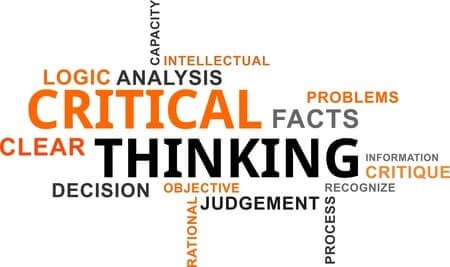
Here is a great assignment for PhD course. Take an un-circulated paper (or major revision) by a good writer. Cut the abstract and intro. Assignment: write the abstract and intro. Solution (one of many): the full paper. Students 1) really learn paper, 2) develop exposition skills.
— Jonathan A. Parker (@ProfJAParker) September 1, 2019
Education systems are in crisis in many ways, one of them is the devaluing of any type of critical thinking.
This also applies, I have found, to carry through to the world of work. The lack of encouragement of and focus on diversity of thought in businesses and organisations is often glaring.
My role as a Sounding Board is therefore often to challenge the thinking of my clients. In fact, when setting a context for our relationship with new clients, “CHALLENGE” is by far one of the most frequent contexts they choose.
So, today a series of thoughts from me on the tweet above, which I feel is a simple, yet brilliant idea to challenge and so encourage both critical and contextual thinking.
Critical Thinking – Education in Crisis
Education systems are increasingly about rankings based upon grades students achieve at high school and even primary school, then on recruitment to funding universities.
This is the law of unintended consequences in action, with rote learning taking the fore, as well as the almost total absence of challenge to the status quo of learning, as well as to orthodoxy in ideas.
In short, lack of bravery, as the livelihoods of those at these educational institutions is dependent upon rankings, recruitment, ratings etc.
If it were not for that understanding of the fear-based drivers of those in charge of (not leading, but in charge of!) education, I would be stunned at quite how poorly (and slowly) education is adapting to the age we live in.
As a real example, a close family member recently completed a Masters Degree at one of the world’s oldest and most highly regarded Universities. Fees alone for the year were nearly $40,000, yet the majority of lectures were given by research assistants literally reading from powerpoints, with (according to this person, plus I reviewed with them some of the curricula) material being taught that is years and years behind current thinking in the field.
In short, they told me: “I could have read all of this with Google, this Masters is mostly a waste of time”.
In an age when the information of the world is available in a moment of searching on our smartphones, when will educators stop trying to cram information into students heads and instead start helping them learn how to think in ways that will support them in a world where AI will take over routine and repetitive roles.
We need creativity, we need both Fluid and Crystallised intelligence, we need creativity, we need to “Think Different” as Steve Jobs used to say for Apple, we need Critical Thinking.
Critical Thinking
Critical thinking is that mode of thinking — about any subject, content, or problem — in which the thinker improves the quality of his or her thinking by skillfully analyzing, assessing, and reconstructing it. Critical thinking is self-directed, self-disciplined, self-monitored, and self-corrective thinking.
~ The Foundation for Critical Thinking
The suggested assignment from Jonathan Parker’s tweet is to take a PhD paper without the abstract and intro (or, in non-academic terms, the Executive Summary), then have the students read the paper then write the abstract and intro after reading it.
A wonderful exercise in Critical Thinking!
Contextual Thinking
As a Sounding Board, the absolute #1 coaching skill I use is to listen for Context, to understand the essence, what is at source for the individual and/or issue they are focussed upon.
The exercise suggested here around the PhD paper involves Critical Thinking and, at the same time, stretches the student to think Contextually.
Application to business
This exercise can apply in business just as easily. Take a Strategic Plan or other key report, remove the summary and introduction, then ask an individual or team to review it and create the summary and introduction.
One more thought.
What if, by some chance, you assign an individual or team to do this for a draft Strategic Plan for the business and they come up with a different contextual summary of what the plan means?
Wouldn’t that be interesting, that in critically analysing the detail and background of the plan, they come up with a different take on the direction and focus for the business?
What might that tell you?
